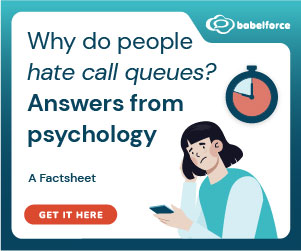Dealing with angry callers is one of the most challenging parts of working in customer service. If not handled properly, these interactions can damage customer relationships and even affect your bottom line.
Understanding how to respond with confidence and professionalism is key to protecting both your people and your brand. In this article, we’ll explore 10 ways to to handle angry customers and regain control of the conversation
What Is the Cost of an Angry Caller?
An irate caller isn’t just a momentary challenge for your customer service team, it represents a significant financial risk to your business.
According to Salesforce, 80% of customers say the experience a company provides is as important as its products and services.
This underscores the importance of addressing customer concerns promptly and effectively. Poor customer service can lead to decreased productivity, as employees often spend valuable work hours addressing service-related issues.
Moreover, the emotional toll on employees dealing with angry callers can result in decreased morale and increased turnover, further impacting the business.
Addressing the concerns of an angry caller promptly and effectively is not just about resolving a single issue – it’s about safeguarding your company’s reputation, retaining customer loyalty, and protecting your agents.
10 Techniques to Calm an Angry Customer
Every difficult call is a chance to turn frustration into resolution. Use these 10 de-escalation techniques to navigate tense conversations with confidence and professionalism.
1. Keep Your Composure
When faced with an angry caller, maintaining your own calm is essential. Responding emotionally or defensively can escalate the situation further.
Instead, take a deep breath, slow your speech, and focus on staying steady, no matter how the caller is reacting. Your calmness will help de-escalate the situation by providing a sense of control and stability, allowing the caller to feel heard without fuelling their frustration.
Remember, by staying composed, you’re not only managing the call effectively but also leading the conversation toward a solution.
2. Choose Your Words Carefully
The language you use can make or break the outcome of a heated conversation. Instead of using phrases that might unintentionally dismiss the caller’s feelings, such as “Calm down” or “You’re overreacting”, focus on validating their emotions.
Phrases like “I understand how frustrating this must be” or “I’m here to help” can create a sense of empathy and show the caller you’re on their side.
It’s also important to stay positive and solution-oriented, steering the conversation away from blame and toward resolving the issue at hand. The right words can transform a tense exchange into a productive one.
If you want to know words you should avoid and what to replace them with, read our article: Negative vs Positive Words in Customer Service – With Examples
3. Give the Customer Time to Express Themselves
Sometimes, the most powerful thing you can do in a heated conversation is simply listen. Allow the customer to vent and express their frustrations fully without interrupting.
This shows respect for their feelings and gives them the chance to feel heard, which can often defuse some of their anger.
By letting them talk, you also gain valuable insights into the root of the issue, which can help you address it more effectively.
4. Be Mindful of Your Tone and Pace
How you say something can be just as important as what you say. When dealing with an angry caller, it’s crucial to keep your tone calm and your voice steady. Avoid raising your voice or speaking too quickly, as this can make the caller feel more defensive.
Speaking clearly and with a relaxed rhythm helps you come across as confident and in control. A calm, respectful tone can ease tension and make it easier to guide the conversation toward a positive outcome.
5. Avoid Putting the Caller on Hold – If You Can Help It
When someone is already upset, placing them on hold can feel like you’re pushing them aside, which may only increase their frustration. If it’s absolutely necessary to pause the conversation, explain why you’re doing so and let them know how long it will take.
For example, say something like, “Would it be okay if I place you on a brief hold while I check this for you? It should only take a moment.”
This small courtesy keeps the caller informed and maintains their trust. Whenever possible, stay on the line and keep them engaged as you work through the issue – it shows you’re prioritizing their concern.
6. Be Honest – Even When It’s Not What They Want to Hear
Honesty builds credibility, especially in high-stress conversations. If you don’t have the answer or a quick solution, it’s better to admit it than to make promises you can’t keep.
Angry callers can often sense when they’re being misled, which only adds fuel to the fire. Instead, let them know you’re committed to finding the right answer or escalating the issue if needed. Being transparent shows integrity and helps establish trust – even if the outcome isn’t immediate.
7. Focus on the Positive
In a tense conversation, your attitude can influence the direction of the call more than you might think. Staying positive doesn’t mean ignoring the caller’s frustration – it means staying focused on what can be done rather than dwelling on the problem.
Use reassuring language like, “Let’s work through this together” or “I’m here to help you find a solution.” A positive mindset can help shift the tone of the conversation and encourage the caller to move from frustration to cooperation. Even small expressions of optimism can make a big difference in how the call plays out.
8. Use a Script – But Don’t Sound Scripted
Scripts can be incredibly helpful in guiding tough conversations, especially when emotions are running high. They provide structure, ensure consistency, and help you avoid saying something that might escalate the situation.
That said, it’s important to use scripts as a guide, not a crutch. Reading word-for-word can come across as robotic or insincere, which can frustrate callers even more. Aim to personalize your delivery – keep the tone natural and conversational while sticking to key messaging that supports resolution.
For examples of how to create effective contact centre scripts, read our article: Positive Scripting For Customer Service – With Examples
9. Make the Most of Your Tools
The right technology can make a big difference to how effectively you handle difficult calls. Use your CRM or call management system to quickly access customer history, notes, and previous interactions, this shows the caller you’re informed and taking their issue seriously.
Real-time tools like screen pop-ups or internal messaging systems can also help you collaborate with colleagues without putting the caller on hold.
10. Focus on a Resolution That Leaves the Customer Satisfied
At the end of the day, your goal is to turn a negative experience into a positive one. That doesn’t always mean giving the customer exactly what they ask for – but it does mean doing everything you can to make them feel valued, respected, and heard.
Offer a clear resolution, explain next steps, and, if appropriate, follow up to ensure the issue is fully resolved. Even a small gesture of goodwill can go a long way toward repairing trust. A happy customer is more likely to return, and even more importantly, more likely to forgive a mistake.
What Is an Angry Caller Policy?
An Angry Caller Policy is a formal framework that outlines how your team should respond to aggressive or emotionally charged calls.
It ensures that every customer is treated consistently and respectfully, while also protecting employees from inappropriate behaviour.
A good policy covers when to escalate a call, how to document difficult interactions, and what steps to take if a caller becomes abusive.
This kind of structure gives your team the confidence to apply de-escalation techniques effectively, knowing they have the support of the business behind them. It turns good intentions into consistent action – and creates a safer, more professional environment for everyone involved.
How to Establish an Angry Caller Policy
A good policy isn’t just written down – it’s lived, reinforced, and easy to apply in real-time. Here’s how to build a policy that’s both effective and easy to follow:
- Define Unacceptable Behaviour: Start by clearly outlining what qualifies as aggressive or abusive behaviour. This might include yelling, threats, discriminatory language, or repeated interruptions. Setting clear boundaries helps staff identify when a caller has crossed the line.
- Set Response Guidelines: Establish a step-by-step process for dealing with angry callers. This could include using de-escalation techniques, giving a warning if the behaviour continues, and knowing when to escalate the issue to a supervisor or end the call.
- Empower and Train Your Team: Equip your team with the tools and training to handle difficult conversations. Regular workshops or refreshers on tone, language, and conflict resolution can make a big difference in how confident and capable they feel.
- Make Documentation Standard Practice: Encourage staff to log any incidents involving angry or abusive callers. This not only helps identify patterns but also protects employees and the business if follow-up action is needed.
- Communicate and Review the Policy Regularly: Ensure the policy is clearly documented, easily accessible, and part of ongoing training. Encourage open dialogue, so your team feels supported and confident in applying it when needed.
This article is a revised version of 10 De-Escalation Techniques to Handle an Angry Caller, originally published by RingCentral.
For more on dealing with angry customers, read these articles next:
- How to Handle Angry Customers in a Call Centre
- What to Say to an Angry Customer
- Rapport Building With Angry Customers – With Examples
Author: Hannah Swankie
Published On: 25th Apr 2025 - Last modified: 18th Nov 2025
Read more about - Expert Insights, Angry Customers, Call Handling, RingCentral















